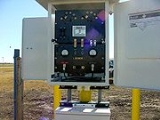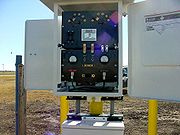
Cathodic protection rectifier
Encyclopedia
Cathodic protection rectifiers are AC
-powered electrical equipment
that provide direct current
for impressed current cathodic protection systems.
 Rectifier units are often custom manufactured and equipped with a variety of features, including oil cooling, automatic output adjustment, various type of electrical enclosure
Rectifier units are often custom manufactured and equipped with a variety of features, including oil cooling, automatic output adjustment, various type of electrical enclosure
s, remote monitoring, remote output adjustment, an AC electrical outlet, selectable AC input setting, three phase AC input.
The rectifier output DC positive cable is connected to the auxiliary anode
s.
The AC power cables are connected to the rectifier input AC cable terminals.
windings and jumper terminals for connection of jumper bars. The jumper bars or tap bars are moved among taps to vary the voltage output of the rectifier unit.
Rectifiers for water tanks and used in other applications are made with solid state
circuits to automatically adjust the operating voltage to maintain a target current output or structure-to-electrolyte potential
.
meters are often installed to show the operating voltage (DC and sometime AC) and current output. Typically a shunt
circuit composed of a calibrated resistor
and voltmeter
is used for current output measurement.
Alternating current
In alternating current the movement of electric charge periodically reverses direction. In direct current , the flow of electric charge is only in one direction....
-powered electrical equipment
Electrical equipment
Electrical equipment includes any machine powered by electricity. They usually consists of an enclosure, a variety of electrical components, and often a power switch...
that provide direct current
Direct current
Direct current is the unidirectional flow of electric charge. Direct current is produced by such sources as batteries, thermocouples, solar cells, and commutator-type electric machines of the dynamo type. Direct current may flow in a conductor such as a wire, but can also flow through...
for impressed current cathodic protection systems.

Enclosure (electrical)
An electrical enclosure is a cabinet for electrical or electronic equipment to mount switches, knobs and displays and to prevent electrical shock to equipment users and protect the contents from the environment...
s, remote monitoring, remote output adjustment, an AC electrical outlet, selectable AC input setting, three phase AC input.
Cable connections
The rectifier output DC negative terminal is connected to the structure to be protected by the cathodic protection system.The rectifier output DC positive cable is connected to the auxiliary anode
Anode
An anode is an electrode through which electric current flows into a polarized electrical device. Mnemonic: ACID ....
s.
The AC power cables are connected to the rectifier input AC cable terminals.
Output adjustment
The output of the rectifier is usually determined by a cathodic protection expert to optimize the level of protection on the target structure. Many rectifiers are designed with taps on the transformerTransformer
A transformer is a device that transfers electrical energy from one circuit to another through inductively coupled conductors—the transformer's coils. A varying current in the first or primary winding creates a varying magnetic flux in the transformer's core and thus a varying magnetic field...
windings and jumper terminals for connection of jumper bars. The jumper bars or tap bars are moved among taps to vary the voltage output of the rectifier unit.
Rectifiers for water tanks and used in other applications are made with solid state
Solid state (electronics)
Solid-state electronics are those circuits or devices built entirely from solid materials and in which the electrons, or other charge carriers, are confined entirely within the solid material...
circuits to automatically adjust the operating voltage to maintain a target current output or structure-to-electrolyte potential
Potential
*In linguistics, the potential mood*The mathematical study of potentials is known as potential theory; it is the study of harmonic functions on manifolds...
.
Meters
Analog or digitalDigital
A digital system is a data technology that uses discrete values. By contrast, non-digital systems use a continuous range of values to represent information...
meters are often installed to show the operating voltage (DC and sometime AC) and current output. Typically a shunt
Shunt (electrical)
In electronics, a shunt is a device which allows electric current to pass around another point in the circuit. The term is also widely used in photovoltaics to describe an unwanted short circuit between the front and back surface contacts of a solar cell, usually caused by wafer damage.-Defective...
circuit composed of a calibrated resistor
Resistor
A linear resistor is a linear, passive two-terminal electrical component that implements electrical resistance as a circuit element.The current through a resistor is in direct proportion to the voltage across the resistor's terminals. Thus, the ratio of the voltage applied across a resistor's...
and voltmeter
Voltmeter
A voltmeter is an instrument used for measuring electrical potential difference between two points in an electric circuit. Analog voltmeters move a pointer across a scale in proportion to the voltage of the circuit; digital voltmeters give a numerical display of voltage by use of an analog to...
is used for current output measurement.

